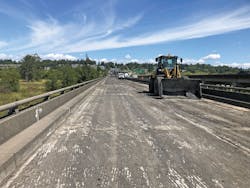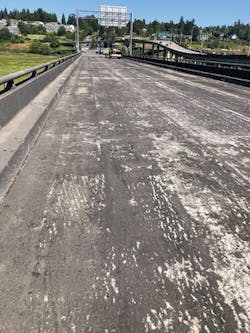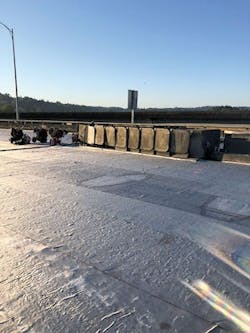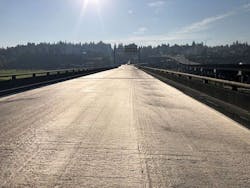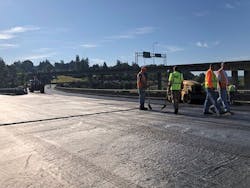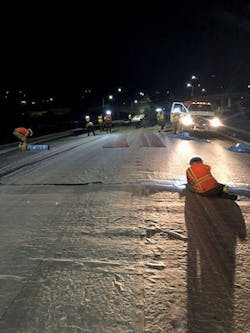Washington State DOT bridge initiative preserves valuable infrastructure on U.S. 2
Washington residents can thank the climate for the state’s lush green foliage, but the road and bridge system—and those that maintain it—don’t share the same enthusiasm.
The wet weather is a bane to the state’s travel infrastructure, plaguing the pavement with perpetual potholes and other problems. Rapid population growth, now 7.4 million, also poses challenges, as vehicles crowd the highways, especially in metropolitan areas.
With the area’s average annual 90 days of sunshine, there are only brief opportunities for repairs. The state’s numerous projects must be completed efficiently, over the approximately five months that allow work, battling even on those days against potential inclemency. Making the most of the state’s funding packages (i.e., Connecting Washington, the “Nickel” Funding program, and Pre-Existing Funds) is imperative to supporting the transportation system and preserving critical infrastructure.
Considering the significant rainfall across the state, keeping a close eye on the roadways and bridges is a top priority for the Washington State DOT (WSDOT). Bridges and bridge decks in Washington are subject to National Bridge Inspection Standards (NBIS), which typically require a two-year reporting cycle. To comply, every bridge within the WSDOT National Bridge Inventory (NBI) undergoes a detailed inspection every two years.
The complex westbound portion of the U.S. 2/I-5 Interchange to Bickford Avenue project cost nearly $11.6 million for necessary repairs. This included applying 536,000 sq ft of geosynthetics, one of the largest quantities ever used by WSDOT for a single waterproofing project. Lane closures were coordinated to allow two full closures and four partial closures. The size of the crew also had to be adjusted, with 15 to 25 workers required to meet the massive needs of manually applying the geosynthetics.
A MAJOR ISSUE IDENTIFIED
During an inspection of a crucial interchange (U.S. 2/I-5), a need for attention was found, reported, recorded in the Bridge Management System, and, after following a required protocol, approved for repair.
The westbound, 3-mile stretch across the U.S. 2/I-5 Interchange from Bickford Avenue is a valuable pipeline for business and commuting, with the bridged area transporting an average of 22,000 vehicles daily. Yet it hadn’t been paved for 16 years, putting it past its useful life. Potholes, ruts, and uneven surfacing resulted in pooling water that not only jeopardized driver safety, but also threatened to destroy the underlying concrete decking. Weekday closures would be problematic, as added traffic on alternate routes could gridlock the area. WSDOT needed a solution that would overcome logistical hurdles yet still be long-lasting.
“U.S. 2 is a vital cross-state corridor for commuters and freight,” WSDOT spokesperson Frances Fedoriska said. “Keeping it a reliable route for the thousands of vehicles who use it every day is critical to our state’s commerce.”
With the extent of the damage fully assessed and the significant challenges now clear, WSDOT set out to put together a plan to remove the existing asphalt and membrane overlay from the bridge deck, repair deteriorated areas in the deck, and apply a new membrane and asphalt overlay. The goal was to produce a solution that would preserve the bridge deck for a further 15 years—or more.
UNIQUE SOLUTION REQUIRED
Having completed the eastbound section with a new concrete structure a few years prior, WSDOT now solicited bids for its counterpart. The westbound project would be complex, costing nearly $11.6 million for necessary repairs. The venture would include the application of 536,000 sq ft of geosynthetics, one of the largest quantities ever used by WSDOT for a single waterproofing project. WSDOT’s Standard Specifications for Road, Bridge, and Municipal Construction called for non-woven geosynthetic materials to exhibit 150 lb minimum tear strength (ASTM D4533), 200 lb minimum grab tensile strength (ASTM D4632), and 220 lb minimum puncture resistance (ASTM D6241).
Project planning and design also would be complicated. To avoid commuter interruptions, lane closures would have to be coordinated. The project allowed for two full closures and four partial closures. The full closures occurred on weekends (7 p.m. Friday to 4 a.m. Monday), with the westbound lanes completely shut off to traffic. The partial closures detoured traffic down a frontage road and merged with the bridge halfway through.
The weather obviously played a factor. Precipitation caused delays, as no work could be done in wet weather, and the colder temperatures at night caused reduced productivity in the removal of old asphalt.
The size of the crew also had to be adjusted, with 15 to 25 workers (versus the typical three to six) required to meet the massive needs of manually applying the geosynthetics.
“There were a lot of pieces to this project — inspecting the structure, making necessary repairs, and preparing it to successfully continue transporting a growing population,” Fedoriska said. “We were confident in the team and plans we put in place to get the job done safely, get the job done right, and get it done while keeping Washington moving.”
THE WHO, WHAT, AND HOW
With the scope of the project established, WSDOT moved on to finding the right contractors to carry out the project. After completing a competitive bidding procedure, Lakeside Industries Inc. was selected. Lakeside Industries had managed a number of paving projects for the state, partnering with Jonnic Construction to do the underlying waterproofing membrane. The crews would collaborate once again, facing the new challenges head-on.
Jonnic chose Crafco GeoTac HS, a high-strength, peel-and-stick waterproofing membrane composed of fully modified SBS asphalt mastic on non-woven polyester geotextiles, the goal being to seal out moisture from concrete or asphalt surfaces while dispersing stress associated with reflective cracking. In addition to providing a more rigid structure that makes it easier to peel, crews were able to achieve nearly twice the required ratings for all WSDOT-required ASTM standards.
With significant deterioration of the pavement evident, the teams started by breaking up the existing asphalt with excavators, cleaning/blowing off the deck, and tearing off the old membrane with shovels and by hand. The preferred method of milling the surface was not an option because of regulations WSDOT has on the weight of paving equipment on bridges. Rotomilling machines are not allowed to be used to remove asphalt on structural bridge decks when full removal is required.
With the surface prepared, the teams attached 55-gal drums of asphalt primer to pumps, spraying it evenly on the area. They then rolled out the 48-in. GeoTac HS across the center, managing the more meticulous edgework with 12-in. rolls of the same.
While typical geocomposite installs require hot mastic to be laid down between the 1.5-in. overlapped seams, engineers pretested the chosen fabrics, finding that a 4-in. overlap would sufficiently seal out moisture and debris when the hot-mix asphalt was applied. This not only resulted in significant savings in man-hours and materials, but also helped the teams speed productivity by eliminating extraneous equipment. Thus, workers were able to stay on task, installing up to 80,000 to 100,000 ft of membrane per shift.
Once installed, Jonnic used Lakeside’s pneumatic, rubber-tired asphalt roller to press the material down and eliminate bubbles. The uniformity of the geocomposite and this rolling process ensured a solid waterproofing base. A single lift of 1.8-in. HMA was applied the morning after each shift.
FINISH LINE IN SIGHT
With the operation 66% complete, the U.S. 2/I-5 Interchange to Bickford Avenue project then shut down for the winter. As weather permits, the teams have begun the spring wrap up.
WSDOT officials remain excited about the progress.
“All the contractors involved with this project are committed to doing the job right, and we’ve been very pleased with the work they’ve completed so far,” Fedoriska said. “We’d also like to thank the public for taking alternate routes and detours during our four weekend closures. It helped our crews accomplish a lot.”
WSDOT Project Engineer Mark Sawyer knows that the proper plan is in place; now it comes down to navigating variables, some that are within the team’s control and some that are outside of it.
“We have a few more segments left,” Sawyer said. “This will be completed with one more full weekend closure. The problem is finding a warm, dry weekend—dry all four days—with no
big traffic-generating events that use this highway.”
Because of its size and complexity, the U.S. 2/I-5 Interchange to Bickford Avenue project will serve as a model for future WSDOT pavement preservation initiatives. The unique planning, skillful execution, and employed materials are expected to dramatically reduce long-term maintenance costs and extend service life. More importantly, it will provide the foundations for a thoroughfare that allows safer travels for residents of the Evergreen State and improved quality of life.
